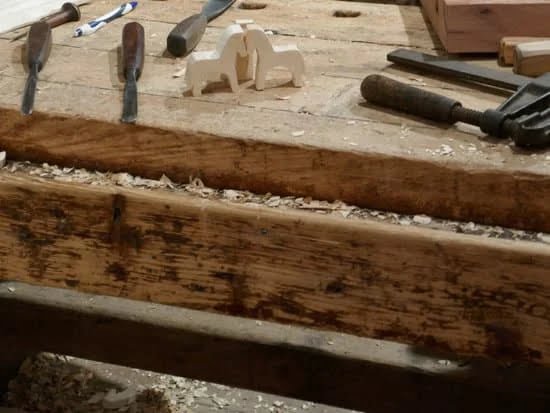Woodworking tools are essential for any woodworking project, but ensuring that they are adequately powered can be a challenge. One common power source for these tools is lead acid batteries, which are known for their reliability and stability. If you’ve ever wondered how many lead acid batteries you need to power your woodworking tools, this comprehensive guide will provide you with the necessary information to make an informed decision.
In this article, we will explore the power requirements of woodworking tools and the basics of lead acid batteries, including how they work and their benefits for powering tools. We will also delve into the crucial process of calculating power needs, determining the energy draw of different woodworking tools, and understanding the factors to consider when choosing lead acid batteries. Additionally, we will discuss the advantages and disadvantages of using lead acid batteries for powering woodworking tools.
Whether you’re a professional woodworker or a hobbyist, it’s important to have a clear understanding of how to efficiently power your woodworking tools. By the end of this article, you’ll have a better grasp on how many lead acid batteries you may need for specific woodworking tools and receive maintenance and care tips for keeping your batteries in optimal condition.
And if you’re curious about alternative power sources aside from lead acid batteries, we’ll explore other options that may suit your needs.
The Basics of Lead Acid Batteries
Lead acid batteries are a popular choice for powering woodworking tools due to their ability to provide a reliable and consistent source of energy. These batteries work by converting chemical energy into electrical energy, making them ideal for use in various power tools. The benefits of using lead acid batteries for powering woodworking tools include their affordability, durability, and the ability to provide high starting power.
How Lead Acid Batteries Work
Lead acid batteries operate through a chemical reaction that takes place between lead plates and sulfuric acid electrolyte. When the battery is connected to a load, such as a woodworking tool, the chemical reaction generates electrical energy that can be used to power the tool. This process is reversible, allowing the battery to be recharged by passing an electrical current through it.
The Benefits of Using Lead Acid Batteries for Woodworking Tools
One of the main advantages of lead acid batteries is their affordability compared to other types of batteries. They are also known for their durability and ability to withstand frequent charging and discharging cycles, making them suitable for heavy-duty use with woodworking tools. Additionally, lead acid batteries are capable of providing high starting power, making them ideal for powering larger woodworking equipment.
When considering how many lead acid batteries are needed to power woodworking tools, it’s important to take into account the specific energy draw of each tool and calculate the total power requirements accordingly. By understanding the basics of lead acid batteries and their benefits as a power source for woodworking tools, individuals can make informed decisions when selecting the right type and quantity of batteries for their needs.
Calculating Power Needs
When it comes to powering woodworking tools, it is essential to understand the power needs of each tool to ensure that they operate efficiently. Calculating the energy draw of different woodworking tools will help in determining how many lead acid batteries are required to power them effectively. This section will delve into the process of calculating power needs and provide insights on the energy consumption of various woodworking tools.
Understanding Power Consumption
Woodworking tools have varying power requirements depending on their type and usage. It is crucial to consider both the wattage and voltage requirements of each tool to accurately calculate the energy draw. Larger power tools such as table saws and jointers typically require more energy compared to smaller handheld devices like drills and sanders. By understanding the power consumption of each tool, woodworkers can determine how many lead acid batteries are necessary to meet their operational needs.
Calculating Energy Draw
To calculate the energy draw of woodworking tools, it is important to identify the wattage rating of each tool. This information is usually provided in the tool’s manual or specifications. By multiplying the wattage by the number of hours the tool will be used, woodworkers can estimate the total energy consumption.
For example, if a table saw has a rating of 1500 watts and will be used for 4 hours, it will consume a total of 6000 watt-hours (Wh) of energy. This calculation will help determine how many lead acid batteries are needed to supply the required power for a specific duration.
Considerations for Efficiency
In addition to calculating power needs, woodworkers should also consider factors that may affect efficiency, such as battery discharge rates and inverter efficiency. Lead acid batteries have specific discharge rates that determine how much current can be drawn from them without causing damage.
Additionally, using an inverter to convert DC power from lead acid batteries into AC power for woodworking tools may result in some energy loss due to conversion inefficiencies. Considering these factors will help in determining not only how many lead acid batteries are needed but also what type and capacity are most suitable for powering woodworking tools efficiently.
Factors to Consider in Choosing Lead Acid Batteries for Woodworking Tools
Lead acid batteries are a popular choice for powering woodworking tools due to their reliability and cost-effectiveness. However, there are several factors to consider when choosing the right lead acid batteries for your specific woodworking needs. Here are some important considerations to keep in mind:
- Capacity: One of the most important factors to consider is the capacity of the lead acid battery. This refers to the amount of energy it can store and provide to the woodworking tools. Different tools will have different power requirements, so it’s essential to choose a battery with an adequate capacity to meet those needs.
- Size and Weight: Woodworking tools often require mobility, so the size and weight of the lead acid battery can be critical. Consider how portable you need your tools to be and choose a battery that can meet those requirements without sacrificing too much power.
- Recharge Rate: The recharge rate of a lead acid battery is another important factor. Depending on how frequently and for how long you use your woodworking tools, you’ll want a battery that can recharge quickly and efficiently.
Considering these factors will help ensure that you choose the most suitable lead acid batteries for your woodworking tools. Additionally, consulting with a professional or doing thorough research on various brands and models can provide valuable insight into which batteries will best suit your specific needs.
Ultimately, having an understanding of how many lead acid batteries are needed to power woodworking tools is crucial in ensuring optimal performance and efficiency in your woodworking projects. By carefully considering these factors, you can make an informed decision when it comes to selecting the right lead acid batteries for your woodworking needs.
Advantages and Disadvantages of Using Lead Acid Batteries for Powering Woodworking Tools
Lead acid batteries have been a popular choice for powering woodworking tools due to their reliability and affordability. However, it is important to weigh the advantages and disadvantages before making a decision on whether to use lead acid batteries for your woodworking tools.
Advantages of using lead acid batteries for woodworking tools:
- Cost-effective: Lead acid batteries are generally more affordable compared to other types of batteries, making them an attractive option for those on a budget.
- Readily available: Lead acid batteries are widely available in various sizes and capacities, making it easy to find the right battery for your specific woodworking tool.
- Durable: Lead acid batteries are known for their durability and ability to withstand deep discharges, making them suitable for heavy-duty use in woodworking applications.
Disadvantages of using lead acid batteries for woodworking tools:
- Heavy and bulky: Lead acid batteries tend to be heavier and bulkier compared to other types of batteries, which can be inconvenient when using handheld woodworking tools.
- Maintenance required: Lead acid batteries need regular maintenance, including checking fluid levels and cleaning terminals, which can be time-consuming.
- Shorter lifespan: Compared to lithium-ion batteries, lead acid batteries have a shorter lifespan and may need to be replaced more frequently.
It is important to consider these advantages and disadvantages when deciding whether lead acid batteries are the right choice for powering your woodworking tools. Understanding the specific power requirements of your tools will also help in determining how many lead acid batteries you will need for efficient operation.
How Many Lead Acid Batteries Do You Need for Specific Woodworking Tools?
When it comes to determining how many lead acid batteries you need for specific woodworking tools, there are a few factors to consider. The first thing to look at is the power requirements of each tool. Different woodworking tools have different energy draw, so it’s crucial to calculate the total power needs before deciding on the number of batteries required.
Another important factor to consider is the capacity of the lead acid batteries. You’ll need to take into account the amp-hour (Ah) rating of each battery and compare that with the power consumption of your woodworking tools. This will give you a better idea of how many batteries you’ll need to power your equipment effectively.
It’s also essential to consider the voltage requirement of your woodworking tools. Lead acid batteries come in various voltages, so make sure that the batteries you choose can supply the necessary voltage for your specific tools. If you’re using multiple tools, you may also need a battery bank system to accommodate different voltage requirements.
| Woodworking Tool | Power Consumption (Watts) |
|---|---|
| Table Saw | 1500 |
| Miter Saw | 1800 |
| Drill Press | 600 |
By considering these factors and performing detailed calculations based on the power needs of your specific woodworking tools, you can determine exactly how many lead acid batteries you need for an efficient and reliable power source.
Maintenance and Care Tips for Lead Acid Batteries When Powering Woodworking Tools
Lead acid batteries are a popular choice for powering woodworking tools due to their reliability and cost-effectiveness. However, proper maintenance and care are essential to ensure that these batteries continue to perform optimally. Here are some tips for maintaining and caring for lead acid batteries when using them to power woodworking tools.
One important aspect of maintaining lead acid batteries is to regularly check the electrolyte levels. The electrolyte in a lead acid battery is a mixture of water and sulfuric acid, and it’s crucial to ensure that the plates inside the battery are fully submerged. Low electrolyte levels can lead to irreversible damage to the battery, so it’s important to top it up with distilled water as needed.
Another crucial maintenance tip is to keep the batteries clean and free from corrosion. Regularly inspect the terminals and cables for any signs of corrosion, and clean them using a solution of baking soda and water if necessary. Additionally, ensuring that the batteries are stored in a cool, dry place can help prolong their lifespan.
When using lead acid batteries to power woodworking tools, it’s important to recharge them properly after each use. Over-discharging the batteries can reduce their capacity over time, so it’s essential to recharge them before they become too depleted. It’s also advisable to use a dedicated charger designed for lead acid batteries, as this can help prevent overcharging or undercharging.
| Woodworking Tool | Energy Draw (Watts) | Number of Batteries Needed |
|---|---|---|
| Circular Saw | 1200 | 2 |
| Drill Press | 500 | 1 |
| Miter Saw | 1800 | 3 |
By following these maintenance tips and calculating your power needs accurately, you can ensure that your lead acid batteries continue to provide reliable power for your woodworking tools.
Alternative Power Sources for Woodworking Tools
In conclusion, lead acid batteries are a reliable and affordable option for powering woodworking tools. Their ability to provide consistent power for extended periods makes them ideal for use in a workshop. However, it is important to consider the energy draw of different woodworking tools and calculate how many lead acid batteries are needed to power them effectively.
Factors like the voltage and amp-hour capacity of the batteries should be taken into account when determining the number needed for a specific tool or combination of tools. Additionally, proper maintenance and care are essential to prolong the lifespan of the lead acid batteries and ensure they continue to perform efficiently.
While lead acid batteries have their advantages, it’s also worth exploring alternative power sources for woodworking tools. Depending on individual needs and preferences, options such as lithium-ion batteries, corded electric tools, or even pneumatic tools could be viable alternatives.
Each of these alternatives has its own set of advantages and drawbacks, so it’s important to carefully weigh the options before making a decision on what power source to use for woodworking tools. Ultimately, finding the right power source will depend on factors such as budget, convenience, and specific woodworking requirements.
Frequently Asked Questions
How Many Batteries Do You Need for Tools?
The number of batteries you need for tools depends on the type and power requirements of the tools. Some tools may require multiple batteries for extended use, while others may function well with just one.
Can I Run Power Tools From Car Battery?
It is possible to run power tools from a car battery using an inverter. However, it is essential to ensure that the inverter can handle the power requirements of the tools and that the car battery is not drained excessively.
What Is the Best Battery Voltage for Power Tools?
The best battery voltage for power tools typically ranges between 18V to 20V. This voltage range provides a good balance between power and battery life, allowing for efficient use of the tools without excessive weight or size.

Hi everyone! I’m a woodworker and blogger, and this is my woodworking blog. In my blog, I share tips and tricks for woodworkers of all skill levels, as well as project ideas that you can try yourself.





